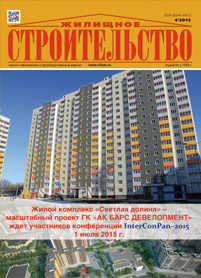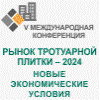Zhilishchnoe Stroitel'stvo №4

April, 2015
Table of contents
P.A. SKACHKOV1, Information Scientist (Architect) (paskaiver@gmail.com), O.S. GORNEVA2, Candidate of Architecture, S.V. SHUTOV1, Engineer, K.V. GNATYUK1, Engineer
1 Municipal Budget Organization “Masterskaya general’nogo plana” (1, office 555, Bankovsky pereulok, 620014, Yekaterinburg, Sverdlovsk Oblast, Russian Federation)
2 Ural State Academy of Architecture and Arts (23, Karla Libknekhta Street, 620075, Yekaterinburg, Russian Federation) Method for Determining the Development Potential of Built-Up Residential Areas
The method making it possible to determine the potential of development of built-up residential areas under the condition of replacement of emergency, shabby, and obsolete housing stock with new and improved objects of housing and civil construction is presented. Its use at the pre-project stage will create a number of requirements for the development of built-up areas, observation of which will ensure a high level of comfort in forming micro-districts, expressed not only in housing but also in the development of social, transport and engineering infrastructure. The proposed method has been realized as a computational model executed in the information system for urban planning and applied in the course of the development of the Scheme of housing-civil construction location of the city district – Municipal formation “the city of Yekaterinburg”. As future directions for research, the formation of indicators of need in places of employment, improvement of territories and limitations of architectural-planning conceptions can be selected. Keywords: development of built-up areas, housing-civil construction, social infrastructure, energy efficiency, potential, power saving, engineering infrastructure, transport infrastructure References
1. Lezhava I. G. Problems of design of the cities of Russian. Zhilishchnoe Stroitel'stvo [Housing Construction]. 2013. No. 5, pp. 5–13/ (In Russian)/
2. Fedosov L.S. Issues of management of town planning development. Zhilishchnoe Stroitel'stvo [Housing Construc tion]. 2014. No. 4, pp. 18–20. (In Russian).
3. Karimov A.M. Main Directions of Architecture and Town Planning Development in the XXI Century. Zhilishchnoe Stroitel'stvo [Housing Construction]. 2009. No. 5, pp. 5–7. (In Russian).
4. Esaulov G.V. Modern Problems and Trends in Architecture. Zhilishchnoe Stroitel'stvo [Housing Construction]. 2013. No. 11, pp. 20–15. (In Russian).
5. Vilner M. Ya., Akbiyev R. T., Morozova T.V. About problems of town-planning policy and management of development of territories in the Russian Federation. Prirodnye i tekhnogennye riski. Bezopasnost' sooruzhenii. 2011 . No. 5, pp. 37–40. (In Russian).
6. Fayzulin I.E. Town-planning policy and development of territories. Role of town-planning policy in development of territorial planning. Rossiiskoe predprinimatel'stvo. 2010. No. 7–2, pp. 112–116. (In Russian).
7. Vavakin L.V. About formation of the state control system by town-planning development of territories, the cities and settlements. Academia. Arkhitektura i stroitel'stvo. 2011. No. 1, pp. 63–66. (In Russian).
8. Gordeeva E.P. Organization of medical service of population in remote micro-districts // Zhilishchnoe Stroitel'stvo [Housing Construction]. 2014. No. 4, pp. 7–9. (In Russian).
9. Belovodov A.N., Nuzhnova S. L. Problems of development of the built-up territories and a way of their decision. Sovremennye tendentsii v gosudarstvennom upravlenii, ekonomike, politike, prave: sbornik statei mezhduna rodnoi nauchnoprakticheskoi konferentsii molodykh uchenykh, aspirantov i studentov [Current trends in public administration, economy, policy, the right: collection of articles of the international nauchnoprak-tichesky conference of young scientists, graduate students and students]. Rostov-na-Donu: YuRIF RANKhiGS. 2013, pp. 13–19. (In Russian).
10. Mikheyeva T.I., Saprykina O. V. Klasterization as tool of the analysis of a street road network of the megalopolis // Sovremennye problemy nauki i obrazovaniya. 2014. No. 5. (http://www.science-education.ru/119-14940/. Date of the address 09.03.2015). (In Russian).
D.A. SAPIN, Engineer, (Dmitry-spbgasu@yandex.ru) Saint-Petersburg State University of Architecture and Civil Engineering (4, 2-nd Krasnoarmeiskaya Street, 190005, St. Petersburg, Russian Federation) Settlements of Foundations of Adjacent Buildings When Arranging the Trench «Slurry Wall»*
A possibility of calculating the settlement of building foundations caused by arrangement of the trench «slurry wall» is considered. On the basis of data of geotechnical monitoring, it is demonstrated that technological settlements of adjacent building when arranging the trench «slurry wall» can be up to 70% of the total settlement caused by new construction. The principal possibility of numerical solution of the set task with help of MKE is shown. The author offers an empirical dependence for calculation of technological settlements of buildings at various parameters of the «slurry wall». The comparison of results of calculation according to the proposed methodology with the data of the geotechnical monitoring at two objects constructed in central districts of St. Petersburg under restrained urban conditions is presented. Keywords: numerical simulation, «slurry wall», technological settlement. References
1. Mangushev R.A., Osokin A.I. Geotekhnika Sankt-Peterburga [Geotechnology of St. Petersburg]. Мoscow: АSV, 2010. 264 p.
2. Osokin A.I., Denisova O.O., Shakhtarina T.N. Technology support of underground construction under conditions of urban development // Zhilishchnoe Stroitel'stvo [Housing Construction]. 2014. No. 3, pp. 16–24. (In Russian).
3. Konyukhov D.S., Sviridov A.I. Deformation process’s calcu lation of the existing buildings during shoring of excavation. Vestnik MGSU. 2011. No. 5, pp. 99–103. (In Russian).
4. Mangushev R.A., Veselov A.A., Konyushkov V.V., Sapin D.A. Numerical simulation of adjoining developments technolo gy settlement in process of trench slurry wall construc tion. Vestnik grazhdanskikh inzhenerov. 2012. No. 5 (34), pp. 87–98. (In Russian).
5. Shashkin A.G., Bogov S.G. Approbation of diaphragm wall technology under geological engineering conditions of St. Petersburg. Promyshlennoe i grazhdanskoe stroitel'stvo. 2012. No. 11, pp. 20–22. (In Russian).
I.V. NEDOSEKO 1 , Doctor of Sciences (Engineering) (nedoseko1964@mail.ru); A.N. PUDOVKIN 2 , Candidate of Sciences (Engineering); V.V. KUZ’MIN 3 , Candidate of Sciences (Engineering); R.R. ALIEV 1 , Engineer
1 Ufa State Petroleum Technological University (1, Kosmonavtov Street, Ufa, 450062, Republic of Bashkortostan, Russian Federation)
2 Kumertau branch of Orenburg State University (3B, 2-nd Sovetsky Lane, Kumertau, 453300, Republic of Bashkortostan, Russian Federation)
3 Belebey branch of Samara State University of Architecture and Civil Engineering (11, Sovetskaya Street, 452930, Belebey, Republic of Bashkortostan, Russian Federation) Haydite Concrete in Housing and Civil Construction of the Republic of Bashkortostan. Problems and Prospects
Technical aspects and prospects of using the no-fines and vibro-compressed structural-heat insulating haydite-concrete in the structures of external walls of low- rise buildings, attic enveloping structures and as a heat insulator of external panel walls of 121U series are considered. Its advantages over traditional mineral wool and organic heat insulators, as a more durable, long-operating and fireproof material, are shown. Keywords: structural-heat insulating claydite-concrete, energy efficiency, attic, well brickwork, thermal resistance, reconstruction, bearing capacity. References
1. Ishchuk M.K. The reasons of defects of external walls with a front layer from a bricklaying. Zhilishchnoe Stroitel'stvo [Housing Construction]. 2008. No. 3, pp. 28–31. (In Russian).
2. Nedoseko I.V., Babkov V.V., Aliev R.R., Kuz'min V.V. Application of a constructional and heat-insulating keramzitobeton in low construction. Zhilishchnoe Stroitel'stvo [Housing Construction]. 2008. No. 3, pp. 26–28. (In Russian).
3. Makridin N.I., Maksimova I.N. Mechanical Behaviour of Structural Haydite Concrete at Axial Compression. Stroitel’nye Materialy [Construction Materials]. 2009. No. 1, pp. 51–53. (In Russian).
4. Galiakberov R.R., Aliev R.R., Nedoseko I.V. Use of a coarse-porous expanded-clay concrete in the protecting designs of mansard floors. Stroitel’nye Materialy [Construction Materials]. 2006. No. 10. Application Arkhitektura. No. 7, pp. 8–10. (In Russian).
5. Nedoseko I.V., Babkov V.V., Aliev R.R., Kuz'min V.V. Application of a constructional and heat-insulating expanded clay concrete at construction and reconstruction of buildings of construction engineering appointment. Izvestiya Kazanskogo gosudarstvennogo arkhitekturno-stroitel'nogo universiteta. 2010. No. 1, pp. 325–330. (In Russian).
V.N. MORGUN1, Candidate of Sciences (Engineering) (morgun_vlad@bk.ru); L.V. MORGUN2, Doctor of Sciences (Engineering), I.A. CHERENKOVA2, Bachelor
1 Academy of Architecture and Arts of the Southern Federal University (105/42, Bolshaya Sadovaya Street, Rostov-on-Don, 344006, Russian Federation)
2 Rostov State University of Civil Engineering (162, Sotcialisticheskaya Street, Rostov-on-Don, 344022, Russian Federation) On the Issue of Efficiency of Heat Insulation of Civil Building Facades
Problems of the energy efficiency of the RF building complex require a balanced approach to the selection of materials for construction and heat insulation of walls of buildings. An analysis of the efficiency of heat insulating materials used at present is made. The prospectivity of the use of fiber foam concrete for producing wall and facing products intended for operation without protection against atmospheric impacts is scientifically substantiated. Keywords: fiber foam concrete, energy efficiency, heat insulation, civil buildings. References
1. Fadeev A.V. Standards of the XXI century in the field of thermal insulation. Energobezopasnost' i energosberezhenie. 2010. No. 2 (32), pp. 16–17. (In Russian).
2. Oparina L.A. Formation of the classification of energy efficiency of buildings. Zhilishchnoe Stroitel'stvo [Housing Construction]. 2011. No. 4, pp. 18–20. (In Russian).
3. Petrikeeva N.A., Sadovnikov A.N., Nikulin A.V. Ways to reduce the energy consumption of buildings. Inzhenernye sistemy i sooruzheniya. 2012. No. 1 (6), pp.13–18. (In Russian).
4. Samarin O.D. Energy balance of residential buildings and possible ways of energy saving. Zhilishchnoe Stroitel'stvo [Housing Construction]. 2012. No. 8, pp. 2–4. (In Russian).
5. Zarubina L.P. Teploizolyatsiya zdanii i sooruzhenii. Materialy i tekhnologii [Thermal insulation of buildings and structures. Materials and technology]. 2nd ed. SPb.: BHV-Petersburg. 2012. 416 p.
6. Alekhin S.V., Novikov A.V. Typology of defects in thermal insulation systems, wet type. Stroiprofil'. 2004. No. 6 (36), pp.140–144. (In Russian).
7. Gorelik P.I., Zolotova Yu.S. Modern insulation materials and features of their application. Stroitel'stvo unikal'nykh zdanii i sooruzhenii. 2014. No. 3 (18), pp. 93–103. (In Russian).
8. Radzievskii S.I. Bezopasnost' zhiznedeyatel'nosti [Health and Safety]. Sevastopol: RIBEST. 2003. 268 p.
9. Morgun L.V. Penobeton: monografiya [Foam concrete: a monograph]. Rostov-on-Don: RGSU. 2012. 154 p.
10. Morgun L.V. On the feasibility of fiber foam concrete in monolithic construction. Izvestiya RGSU. 2003. No. 7, pp. 106–111. (In Russian).
11. Morgun V.N., Bogatina A.Yu., Morgun L.V., Smirnova P.V. Structural opportunities fiber foam concrete non-autoclave hardening. Stroitel'nye Materialy [Construction materials]. 2012. No. 4, pp. 14–16. (In Russian).
12. Ishchuk M.K. Otechestvennyi opyt vozvedeniya zdanii s naruzhnymi stenami iz oblegchennoi kladki [Domestic experience in the construction of buildings with exterior walls made of lightweight masonry]. Moscow: Stroimaterialy. 2009. 360 p.
T.A. AKHMYAROV, Engineer ( tagir-a@yandex.ru), V.A. LOBANOV, Engineer, A.V. SPIRIDONOV, Candidate of Sciences (Engineering), I.L. SHUBIN, Doctor of Sciences (Engineering), Director Research Institute for Building Physics (NIISF RAASN) (21, Lokomotivny Passage, 127238, Moscow, Russian Federation) Efficiency of Ventilated Envelopes and Fenestration with Active Recuperation of Outlet Heat Flow
To assess the efficiency of new principles of designing envelopes and fenestration with the use of techniques of active energy saving with active recuperation of outlet heat flow proposed by the authors, NIISF RAASN during the 2013–2014 carried out the wide-scale experimental studies in climatic chambers of the institute. On the basis of the results of preliminary studies conducted in 2010–2012 the main parameters of a new generation of envelopes and fenestration with active recuperation of outlet heat flow have been determined. The efficiency of new principles of designing and principal technical solutions for energy efficient ventilated envelopes and fenestration on the basis of the mechanism of active recuperation of outlet heat flow and moisture is confirmed. Keywords: energy saving, energy efficiency, ventilated envelopes and fenestration, active energy saving system, recuperation of outlet heat flow and moisture. References
1. Akhmyarov T.A., Spiridonov A.V., Shubin I.L. The new principles of design and assessment of external envelopes with use of heat recuperation and other technologies of ‘active’ energy saving. Zhilishchnoe Stroitel'stvo [Housing Construction]. 2014. No. 6, pp. 8–13. (In Russian).
2. Akhmyarov T.A., Spiridonov A.V., Shubin I.L. The energy efficient ventilated envelopes with active recovery of the leaving thermal stream. Zhilishchnoe Stroitel'stvo [Housing Construction]. 2014. No. 10, pp. 38–42. (In Russian).
3. Akhmyarov T.A., Spiridonov A.V., Shubin I.L The energy efficient ventilated fenestration. Energosberezhenie. 2014. No. 8, pp. 62–65. (In Russian).
4. Belyaev V.S., Lobanov V.A., Akhmyarov T.A. The decen tralized forced-air and exhaust system of ventilation with recovery of heat. Zhilishchnoe Stroitel'stvo [Housing Construction]. 2011. No. 3, pp. 73–77. (In Russian).
5. Akhmyarov T.A., Belyaev V.S., Spiridonov A.V., Shubin I.L. System of active energy saving with heat recovery. Energosberezhenie. 2013. No. 4, pp. 36–46. (In Russian).
6. Fokin K.F. Stroitel’naya teplotekhnika ograzhdayushchikh chastey zdanii. Moscow: AVOK-PRESS, 2006. 252 pp.
O.D. SAMARIN, Candidate of Sciences (Engineering) (samarin1@mtu-net.ru) Moscow State University of Civil Engineering (26, Yaroslavskoe Highway, 129337, Moscow, Russian Federation) Payback Evaluation of Increasing of Thermal Protection of Non Transparent Building Fences Under Climate Changing The economical expediency of using decreased thermal performance of external building enclosures in terms of demands of SP 50.13330.2012 under conditions of changing of climatic parameters is considered. The calculation results of specific thermal performance, the investment costs for thermal insulation and heat consumption at the different values of thermal resistance of the main external enclosures for the series of residential buildings are presented. The analysis of obtained data is given and conditions of payment back of basic level of thermal performance using combined discounted costs are shown with determination of operating costs for thermal corresponding the actual climatic conditions of the heating season of the 2013–1014th years as one of the warmest during the last 15 years. The comparison of the results of calculations with the conclusions done by the author’s former researches for the standardized climatic parameters contained in SP 131.13330.2012 is conducted. Keywords: energy efficiency, energy saving measures, thermal resistance, specific thermal performance of building, investment costs, payback term, heating season, climate warming. References
1. Gagarin V.G. Macroeconomic features of justification of energy saving measures during increase of thermal performance of building enclosures. Stroitel'nye Materialy [Construction Materiаls]. 2010. No. 3, pp. 8–16. (In Russian).
2. Gagarin V.G., Kozlov V.V. The requirements to the thermal performance and energy efficiency in the project of the actualizationed SNiP «Thermal performance of the buildings». Zhilishchnoe Stroitel'stvo [Housing Construction]. 2011. No. 8, pp. 2–6. (In Russian).
3. Gorshkov A.S. Energy efficiency in construction: problems of standardizing and measures to decrease energy consumption of buildings. Inzhenerno-stroitel’ny zhurnal. 2010. № 1, рр. 9–13. (In Russian).
4. Dylewski R., Adamczyk J. Economic and ecological indicators for thermal insulating building investments. Energy and Buildings. 2012. No. 54, рр. 88–95.
5. Lapinskiene V., Paulauskaite S., Motuziene V. The analysis of the efficiency of passive energy saving measures in office buildings. Papers of the 8th International Conference “Environmental Engineering”. Vilnius. 2011. P. 769–775.
6. Samarin O.D. Obosnovaniye snizheniya teplozashchity ograzhdeniy s ispol’zovaniyem aktualizirovannoy redakciyi SNiP 23-02–2003 [Substantiation of decreasing of thermal performance of building enclosures using actualized edition of SNiP 23-02–2003]. Zhilishchnoe Stroitel'stvo [Housing Construction]. 2014. No. 3, pp. 46–48. (In Russian).
7. Samarin O.D. Voprosy ekonomiki v obespechenii mikroklimata zdaniy [Problems of economics in maintenance of a building microclimate]. 2nd ed., revised and suppl. Moscow: Izdatel’stvo ASV. 2015. 134 p. (In Russian).
8. Gagarin V.G. Economical analysis of increase of thermal performance level of building enclosures]. Stroitel'nye Materialy [Construction materiаls. 2008. No. 8, pp. 41–47. (In Russian).
9. Samarin O.D, Grishneva E.A. Increasing of building energy efficiency using smart technologies. Energosberezheniye i vodopodgotovka. 2011. № 5, рр. 12–14. (In Russian)
L.M. KOLCHEDANTSEV, Doctor of Sciences (Engineering) (vschief@yandex.ru), V.V. SOKOLNIKOV, Engineer Saint-Petersburg State University of Architecture and Civil Engineering (4, 2-nd Krasnoarmeiskaya Street. 190005 St. Petersburg, Russian Federation) Substantiation of Platform of Automation of Operative Planning and Management System of Construction Company
A theoretic approach to the development of models of organization of the complex of construction and ensuring processes and its software support during the execution of construction and erection works (CEW) is proposed. Two schemes and boundary conditions are presented as a substation of construction of static and dynamic mathematical models of organization of information exchange while maintaining the complex of processes of the construction company during the execution of CEW. Goals and criteria of the construction company management in the course of realization of general contractor and subcontractor functions are formulated. Main goals of the automation of construction company operative management are formulated. An analysis of the advantages of existing platforms of automation is made. Keywords: operative management, general contracting company, subcontracting company, goals and criteria of operative management, processes, parameters of resource expenditure, platform and goals of automation. References
1. Shalennyj V.T., Papirnyk R.B. Increase of technological effectiveness of design solutions of monolithic and combined and monolithic buildings and constructions. Promyshlennoe i grazhdanskoe stroitel'stvo. 2010. No. 2, рр. 19–21. (In Russian).
2. Hromec Ju.N, Gelajko V.B. Choice of rational design decisions taking into account costs of operation of buildings. Promyshlennoe i grazhdanskoe stroitel'stvo. 2008. No. 4, рр. 40–42. (In Russian).
3. Eremeev P.G. Scientific and technical maintenance at design, production and installation of a metalwork. Montazhnye i special'nye raboty v stroitel'stve. 2007. No. 3, рр. 28–42. (In Russian).
4. Tikhonov I.N. The principles of calculation of durability and designing of reinforcing of beams of overlappings of buildings from monolithic reinforced concrete for prevention of the progressing destruction. Zhilishchnoe Stroitel'stvo [Housing Construction ]. 2013. No. 2, рр. 40–45. (In Russian).
5. Socolnikov V. V. Modeling of ensuring quality of installation and construction works and organizational development of the construction enterprise. Zhilishchnoe Stroitel'stvo [Housing Construction]. 2013. No. 5, рр. 42–49. (In Russian).
6. Kapriyelov S.S., Sheynfeld A.V., Kiselyova Yu.A. Features of the monitoring system of quality of high-strength concrete. Stroitel’nye Materialy [Construction Materials]. 2012. No. 2, рр. 63–68. (In Russian).
I.A. PROKOFIEVA, Candidate of Architecture(archirina@mail.ru) Moscow Architectural Institute (State Academy) (11/4, Structure 1, Bldg 4, Rozhdestvenka Street, 107031, Moscow, Russian Federation) Panel Five-Storey Buildings of the 1960s: Demolition or Reconstruction – Current Trends
The history of creation and modern reconstruction of residential panel five-storey buildings of the 1960s. Today, domestic and foreign experts and architects say that this housing meets modern requirements not only municipal affordable housing, but also meets modern standards of comfort sustainable housing for a number of its key features. Many architects, working in the context of current conditions and needs in the development, aimed at the reconstruction and modernization of residential objects of this type. The paper discusses some examples of the modernization of prefabricated houses. Keywords: housing, housing planning, standards, reconstruction, demolition, typing, prefabricated houses. References
1. Vasilyeva A.V. Experimental design in large-panel housing construction. Zhilishchnoe Stroitel'stvo [Housing Construction]. 2012. No. 2, pp. 10–15. (In Russian).
2. Prokofieva I.A., Vasilyeva A.V. Current state of the Moscow low ensembles. Zhilishchnoe Stroitel'stvo [Housing Construc tion]. 2012. No. 12, pp. 42–44. (In Russian).
3. Prokofieva of I.A. Vasilyev of A.V. Istoriya of the comfortable dwelling on the example of the Moscow low ensembles. Zhilishchnoe Stroitel'stvo [Housing Construction]. 2011. No. 5, pp. 5–8. (In Russian).
4. Prokofieva I.A. Morphotypes of an individual house. Holland, Japan: the traditional – modern forms. Zhilishchnoe Stroitel'stvo [Housing Construction]. 2014. No. 11, pp. 26–29. (In Russian).
5. Prokofieva I.A. Geometrical expression of physical regula rities of «a live square» in architecture. Zhilishchnoe Stroi- tel'stvo [Housing Construction]. 2015. No. 1, pp. 33–35. (In Russian).
6. Meerovich M. G. Ernst Mai: «Rational» housing for Russia. The Architecton: News of higher education institutions. 2011. No. 36, рр. 14. (In Russian).
7. Korniyenko V.D., Chikota S. I. Stages of development of multiroom houses for mass building of the cities of Russia. Actual problems of modern science, equipment and education. 2014. T. 2. No. 1, рр. 19–23. (In Russian).
8. Yumasheva E.I., Sapacheva L.V. House-building industry and social order of time. Stroitel'nye Materialy [Construction materiаls]. 2014. No. 10, pp. 3–11. (In Russian).
9. Davidyuk A.N., Nesvetayev G.V. Large-panel housing construction – the important reserve for the solution of housing problem in Russia. Stroitel'nye Materialy [Construction materiаls]. 2013. No. 3, pp. 24–25. (In Russian).
10. Gryzlov of V.S. Shlakobetona in large-panel housing construction. Stroitel'nye Materialy [Construction materiаls]. 2011. No. 3 , pp. 40–41. (In Russian).
V.P. ETENKO, Doctor of Architecture (EVP100@yandex.ru), S.K. SARKISOV, Doctor of Architecture State University of Land Use Planning (15, Kazakova Street. 105064, Moscow, Russian Federation) Problems of Educational Design Quality
New forms of the organization of architectural-design activity in the country gave rise to a new direction which combines the architectural direction with business activities into a single, interconnected production: architectural-building business. There was a clash of traditional and modern views in the architectural education, which was unprepared for the new ideology. On the one hand, dogmas of past methods and approaches, often hindering the progress in architecture, on the other – premature confidence in the omnipotence of exact methods leading to an underestimation of the creative potential of an architect- creator. This situation caused the emergence of the social order for a new type of architect who can be not just a designer, but a specialist able to solve the complex of organizational problems of architectural and construction practice. However, the lack of possible “feeding” of students with new, “informative” textbooks and manuals, study guides and other materials in which progressive foundations of complex architectural design, working modeling, the use of computer equipment and so on are laid, is in need of serious and careful “pererstroika”. Keywords: educational designing, architectural-construction business, new type of architect, normative base, complex design. References
1. Kim I.N. Professional activity of the teacher of the Russian HIGHER EDUCATION INSTITUTION: the developed stereotypes and need of changes. Vysshee obrazovanie v Rossii. 2014. No. 4, рр. 39–47. (In Russian).
2. Muratova E.I., Krasnyansky M.N., Voyakina E.Yu. Impro vement of management processes of training of the top skills at regional university. Vysshee obrazovanie v Rossii. 2014. No. 4, рр. 30–39. (In Russian).
3. Gryzlov V.S. Problems of Training of Masters of “Building” Profession. Zhilishchnoe Stroitel'stvo [Housing Construction]. 2010. No. 4, pp. 20–21. (In Russian).
4. Gryzlov V.S. Competency-Module Approach in the Cour se of Training of Bachelor-Builders. Stroitel'nye Materialy [Construction materiаls]. 2014. No. 10, pp. 55–62. (In Rus- sian).
 |
 |
 |
 |
 |
 |
 |
